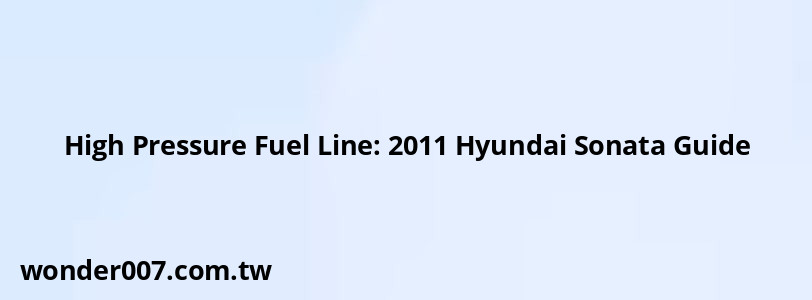High Pressure Fuel Line: 2011 Hyundai Sonata Guide

The 2011 Hyundai Sonata features a high pressure fuel line that is crucial for the vehicle's fuel delivery system. Understanding its function, potential issues, and maintenance can help owners ensure their vehicles operate smoothly.
Overview of the High Pressure Fuel Line
The high pressure fuel line in the 2011 Hyundai Sonata is responsible for transporting fuel from the fuel pump to the engine at high pressures necessary for efficient combustion. This system operates at pressures ranging from 2.0 to 15.0 MPa (approximately 290 to 2175 psi) depending on engine demands.
Common Issues with the High Pressure Fuel Line
- Fuel Leaks: One of the most significant problems associated with the high pressure fuel line is leakage. This can occur due to wear and tear or improper installation. Leaks can lead to fuel wastage and pose safety hazards.
- Fuel Pump Failures: If the high pressure fuel pump fails, it can cause insufficient fuel delivery to the engine, leading to performance issues such as stalling or rough idling.
- Electrical Issues: Sometimes, electrical problems can affect the operation of the fuel pump, resulting in low pressure and poor engine performance.
Maintenance Tips
- Regular Inspections: Periodically check the high pressure fuel line and connections for any signs of wear, cracks, or leaks. Early detection can prevent more severe issues down the road.
- Proper Installation: If replacing or repairing the fuel line, ensure that all connections are secure and that the line is routed correctly to avoid kinks or bends.
- Use Quality Parts: When replacing components of the fuel system, opt for OEM (Original Equipment Manufacturer) parts to ensure compatibility and reliability.
Replacement Process
If you need to replace the high pressure fuel line or pump, follow these steps:
1. Disconnect Battery: Always start by disconnecting the negative terminal of the battery to prevent any electrical shorts.
2. Remove Engine Cover: Take off any covers obstructing access to the fuel line and pump.
3. Relieve Fuel Pressure: Before disconnecting any lines, relieve pressure in the fuel system by removing the fuel pump relay and starting the engine until it stalls.
4. Disconnect Fuel Lines: Carefully disconnect the high pressure fuel line from both ends using appropriate tools, ensuring you have rags handy to catch any spillage.
5. Install New Components: Install new lines or pumps by reversing the removal process. Ensure all connections are tight and secure.
6. Reconnect Battery and Test: Once everything is reassembled, reconnect the battery and start the engine to check for leaks and proper operation.
FAQs About High Pressure Fuel Line in 2011 Hyundai Sonata
FAQs About High Pressure Fuel Line
- What are signs of a failing high pressure fuel line?
Signs include fuel leaks under the vehicle, engine stalling, or difficulty starting. - Can I drive my Sonata with a leaking fuel line?
No, driving with a leaking fuel line is dangerous due to fire risks; it should be repaired immediately. - How often should I inspect my fuel lines?
It's advisable to inspect your fuel lines at least once a year or whenever you notice performance issues.
By understanding your 2011 Hyundai Sonata's high pressure fuel line system, you can take proactive steps to maintain it effectively and ensure your vehicle runs efficiently.
Related Posts
-
Oil for 2018 Hyundai Elantra: Best Options & Guide
27-01-2025 • 192 views -
2018 Ram 2500 Block Heater Cord Installation Guide
27-01-2025 • 189 views -
Engine Oil Drain Plug Torque Chart: 2021 Guide
30-01-2025 • 179 views -
Check BSD System: Hyundai Tucson Safety Features Explained
26-01-2025 • 218 views -
2012 Ford Fusion Tail Light Bulb Replacement Guide
26-01-2025 • 159 views
Latest Posts
-
Are O2 Sensors Covered Under Warranty
01-02-2025 • 376 views -
How To Turn Off Paddle Shifters Mercedes
01-02-2025 • 377 views -
Power Steering Fluid Leak On Passenger Side
01-02-2025 • 457 views -
Rear Brake Caliper Piston Won't Compress
01-02-2025 • 356 views -
2015 Chevy Traverse AC Recharge Port Location
01-02-2025 • 409 views
Popular Posts
-
Hino Warning Lights: Understanding Dashboard Alerts
26-01-2025 • 765 views -
V12 Engine Costs: What You Need to Know
26-01-2025 • 679 views -
EPC Warning Light: What It Means for Your Vehicle
27-01-2025 • 630 views -
EPC Light: Understanding Causes and Solutions
26-01-2025 • 1053 views -
Power Steering and ABS Light On: Causes and Solutions
27-01-2025 • 643 views
